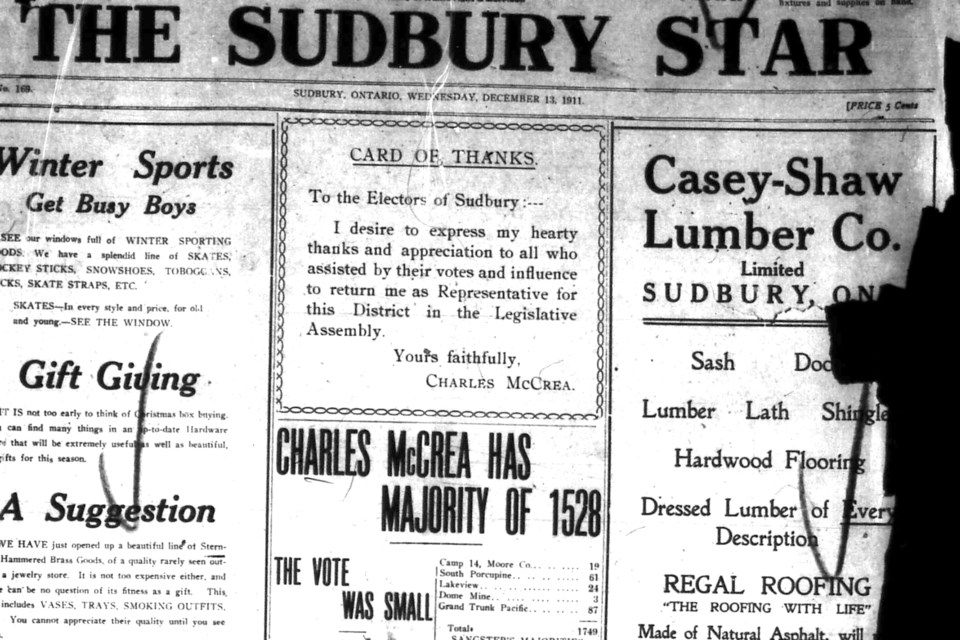Last week’s voter turnout was a modern-history low for a general provincial election locally, but not the lowest-ever recorded in the Greater Sudbury area.
The 1911 voter turnout in the Sudbury electoral district earns the distinction, with only 29.2 per cent of eligible voters turning out to cast a ballot. Given the fact that women weren’t allowed to vote in Ontario until April 12, 1917, the term “eligible voters” carried even greater weight then than it does today.
Next up after 1911 when it comes to low voter turnout was the Sudbury electoral district turnout of 39.7 per cent in 2015, but that was for a byelection and not a general election.
The 1905 election in the Nipissing West electoral district (which was retooled as part of the Sudbury electoral district in 1908) is next with a voter turnout of 43.8 per cent.
Last week’s election is the next-lowest on the list, with a turnout of 45.5 per cent recorded in Sudbury and 43.9 per cent recorded in Nickel Belt for an overall voter turnout of 44.7 per cent.
Although some local candidates shared some ideas as to why voter turnout was so low this year, it remained on par with the province’s overall record-low 43-per-cent turnout, which was a significant drop from the 57 per cent recorded in 2018.
With voter turnout across the province sitting at 64.3 per cent in 1911, it begs the question: Why was Sudbury’s turnout so disproportionately low that year?
To solve this curiosity, Sudbury.com visited the Greater Sudbury Public Library’s main downtown branch to dig through historic newspapers they have available on microfiche.
The Dec. 13, 1911, edition of The Sudbury Star declared Conservative candidate Charles McCrea as the Sudbury electoral district winner in a front-page story, the subheadline of which was “The vote was small.”
“In an election which was remarkable only for the small vote that was polled, Mr. Charles McCrea was chosen by the electorate on Monday as the representative for Sudbury in the next Legislature,” the story began, noting that with only three polls still to share their results he was the clear winner.
“Weather conditions were anything but favourable for getting out the vote,” the story continued, noting that roads were in rough shape.
Another possible factor was a lack of viable political opponents in that year’s election.
McCrea’s only opponent was Socialist Frank Sangster, whom the Star lambasted in a front-page story on Dec. 2, 1911 titled, “Mr. Sangster was in town.”
In the story, the Star opines, “Mr. Sangster has little to offer the electors of Sudbury in the way of a practical policy. His chief regret was that the people did not understand Socialism – a very wide subject you will admit.”
They continue to note that Sangster “has failed to note that we are already carrying considerable excess baggage in our numerous trials and tribulations without having a cargo of the ‘Religion of Humanity’ hoisted on to us at this stage of the game,” and that the candidate “cannot .. be taken seriously on Dec. 11th.”
As for a lack of Liberal candidate to come forward, McCrea offered his theory for the vacancy shortly before the Dec. 11 election, which the Star paraphrased as: “The Liberals of New Ontario are broad-minded enough to see that the government has done good work for this part of the country and their recognition of this fact was that they had decided not to oppose him.”
“Prosperous farmer of Rayside” Joseph Belanger was lined up to seek election for the Liberals in mid-November, but dropped out “provided the Socialist candidate from Porcupine would publicly state that he would support bilingual schools, if elected, and the issue came before the House,” according to a Nov. 22, 1911, story in the Star.
Sangster agreed, and Belanger dropped out.
By Dec. 13, 1911 and with three polls still not reporting, the Star reported that McCrae had earned a decisive victory at 41 of 47 polling stations to report, signalling his entrance into provincial politics.
McCrea, for whom the McCrea Heights neighbourhood of Valley East was named after, remained the electoral district’s representative in Queen’s Park until 1934, when Liberal candidate Edmond Lapierre took the seat.
Tyler Clarke covers city hall and political affairs for Sudbury.com.
